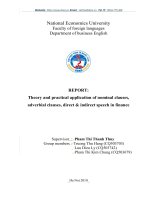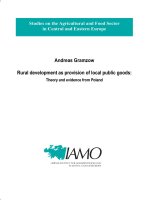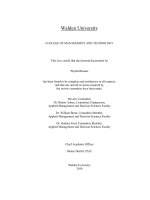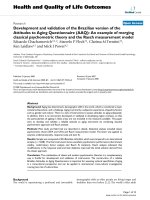Cognitive moral development theory and moral maturity of accounting and finance professionals
Bạn đang xem bản rút gọn của tài liệu. Xem và tải ngay bản đầy đủ của tài liệu tại đây (1.73 MB, 142 trang )
Walden University
COLLEGE OF MANAGEMENT AND TECHNOLOGY
This is to certify that the doctoral dissertation by
Phyllis Rhodes
has been found to be complete and satisfactory in all respects,
and that any and all revisions required by
the review committee have been made.
Review Committee
Dr. Robert Aubey, Committee Chairperson,
Applied Management and Decision Sciences Faculty
Dr. William Brent, Committee Member,
Applied Management and Decision Sciences Faculty
Dr. Rodney Ford, Committee Member,
Applied Management and Decision Sciences Faculty
Chief Academic Officer
Denise DeZolt, Ph.D.
Walden University
2010
ABSTRACT
Cognitive Moral Development Theory and Moral Maturity of
Accounting and Finance Professionals
by
Phyllis N. Rhodes
M.B.A., Belhaven College, 1999
B.S.B.A. Alcorn State University, 1983
Dissertation Submitted in Partial Fulfillment of
the Requirements for the Degree of
Doctor of Philosophy
Applied Management and Decision Sciences
Walden University
February 2010
ABSTRACT
Fraud has infiltrated several corporate financial statements, thus bringing attention to the
accounting and finance profession. The purpose of this study was to determine if age,
gender, and former ethics education had an impact on the moral decision-making process
of finance and accounting professionals below the Chief Executive Officer (CEO) and
Chief Financial Officer (CFO) levels. Due to the increased number of women in the
workforce, it is important to understand the differences in ethical judgment between
women and men. It is also important to understand if ethical maturity increases with age
and it is equally important to make a determination as to whether business ethics courses
are adequate in meeting the demand for integrity in financial reporting. Kohlberg’s theory
of cognitive moral development was used as the theoretical foundation, and the Defining
Issues Test (DIT) survey was used to collect data via the Internet. ANOVA and
independent samples t test results revealed no statistical difference in ethical maturity by
any of the 3 independent variables; age, gender, and formal ethics training. One
recommendation coming from this study is that companies and educational institutions
should develop more ethics courses that are targeted at finance and accounting
professionals. The implications for positive social change result from the study’s
contribution toward providing an avenue by which corporations and educational
institutions can began to develop ethics courses that will prepare students to be ethical
finance professionals and will restore consumer confidence and strengthen satisfaction in
the nation’s financial institutions and markets.
Accounting and Finance Professionals
by
Phyllis N. Rhodes
M.B.A., Belhaven College, 1999
B.S.B.A Alcorn State University, 1983
Dissertation Submitted in Partial Fulfillment
of the Requirements for the Degree of
Doctor of Philosophy
Applied Management and Decision Sciences
Walden University
February 2010
UMI Number: 3396810
All rights reserved
INFORMATION T
O ALL USERS
The quality of this reproduction is dependent upon the quality of the copy submitted.
In the unlikely event that the author did not send a complete manuscript
and there are missing pages, these will be noted. Also, if material had to be removed,
a note will indicate the deletion.
UMI 3396810
Copyright 2
010
by ProQuest LLC.
All rights reserved. This edition of the work is protected against
unauthorized copying under Title 17, United States Code.
ProQuest LLC
789 East Eisenhower Parkway
P.O. Box 1346
Ann Arbor, MI 48106-1346
ii
ACKNOWLEDGMENTS
I wish to first acknowledge the Lord Jesus Christ for helping me to complete this
arduous and monumental task in my life. I would also like to acknowledge all the people,
colleagues, friends, and family who supported this effort by offering encouragement,
assistance, patience, and guidance. I want to give specific acknowledgement to Dr.
Robert Aubey who served as my faculty mentor and committee chair. Dr. Aubey and my
other committee members, Dr. William Brent and Dr. Rodney Ford, have provided
constant guidance to me throughout the dissertation process. I am grateful to them for
their expertise and guidance. I would also like to thank the University Reviewers for their
review and assistance in making my dissertation a much better product. Last but not least,
I would like to give special acknowledgement to my husband Michael Rhodes, Sr. for his
understanding during long nights when I was constantly on the computer. My two
children Ava Rhodes and Michael Rhodes, Jr. have been encouraging and patient with
me throughout this process. I dedicate this work to my family and God whom I love and
appreciate more than anything else in this world.
iii
TABLE OF CONTENTS
LIST OF TABLES v
LIST OF FIGURES vi
CHAPTER 1: INTRODUCTION TO THE STUDY 1
Background 1
Problem Statement 2
Research Questions 3
Purpose of the Study 7
Cognitive Moral Development and Ethical Decision Making 10
Operational Definitions 12
Assumptions 15
Limitations of the Study 16
Scope 17
Significance and Social Change 17
Summary 20
CHAPTER 2: LITERATURE REVIEW 22
Introduction 22
The Corporate Ethical Dilemma: Shareholder Wealth Maximization 22
Finance Theories 27
Cognitive Moral Development Evolution 34
Neo-Kohlbergian Era 43
Ethics Education 46
Gender and Ethics 49
Age and Ethics 51
CHAPTER 3: RESEARCH METHOD 54
Introduction 54
Research Design and Approach 55
Research Data and Sample Size 56
Instrumentation and Materials 57
Data Collection 63
Protecting Participant Rights 65
Summary of Methodology 66
CHAPTER 4: RESULTS 68
Introduction 68
Data Collection and Instrumentation 69
Data Analysis 75
Demographics Analysis 76
iv
Results of Hypothesis Tests 78
Summary 88
CHAPTER 5: RECOMMENDATIONS AND CONCLUSIONS 90
Findings and Data Analysis 91
Application of Cognitive Moral Development Theory 96
Social Change Implications 97
Recommendations for Action 99
Recommendations for Further Study and Limitations 101
Conclusion 102
REFERENCES 104
APPENDIX A: EMAIL ANNOUNCING RESEARCH STUDY 111
APPENDIX B: SURVEY INSTRUMENT 112
APPENDIX APPENDIX C: : PERMISSION TO USE SURVEY 128
APPENDIX D: THANK YOU EMAIL 129
APPENDIX E: CURRICULUM VITAE 130
v
LIST OF TABLES
Table 1. Piaget’s Cognitive Development 35
Table 2. Rest’s Four Components of Moral Behavior 45
Table 3. Women Labor Statistics in Thousands 49
Table 4. Mean N2 Score and Standard Deviations by Age Category 59
Table 5. Defining Issues Test Stage Score Definitions 70
Table 6. Summary of Schema Scores - Age 72
Table 7. Summary of Schema Scores - Gender 72
Table 8. Summary of Schema Scores – Formal Ethics Training 73
Table 9. Demographics Analysis 76
Table 10. P-Score for each Independent Variable 78
Table 11. DIT-2 Scores Descriptive Statistics by Age 81
Table 12. DIT-2 Scores ANOVA by Age using P-Score 82
Table 13. DIT-2 Scores ANOVA by Age using N2-Score 83
Table 14. DIT-2 Scores Descriptive Statistics by Gender 84
Table 15. DIT-2 Scores T-test by Gender 85
Table 16. DIT-2 N2-Scores ANOVA by Gender 86
Table 17. DIT-2 Scores Descriptive Statistics Ethics Training 87
Table 18. DIT-2 N2 Scores ANOVA for Ethics Training 87
Table 19. Summary and Interpretations 95
Table 20. Comparison between SCMD and DIT Scoring 96
vi
LIST OF FIGURES
Figure 1. Fraud triangle 24
CHAPTER 1: INTRODUCTION TO THE STUDY
Background
Financial management within publicly owned companies has received a huge
amount of attention over the past decade. Several studies (Hake, 2005; Malone, 2006;
Pandey & Verma, 2005) have been conducted in the area of business ethics since the
collapse of companies such as Enron, WorldCom, and other major corporations that were
found to be in violation of numerous financial reporting regulations. Previous research on
this topic has primarily focused on the executive level positions, such as CEOs, CFOs,
and Board of Directors; however, little research has examined the ethical decision-
making processes of finance professionals below the CFO level in public firms.
Rocknesses in their (2005) Journal of Business Ethics article suggested that Enron’s
activities included many employees who had full knowledge of the deceptive accounting
schemes. Those who knew about the accounting fraud and did nothing to stop it
perpetuated the corrupt and unethical behavior, yet the question of how so many other,
lower level finance professionals could go along with the fraud has yet to be explored.
This research will focus on determining the thought process of those who went along
with these crimes knowing that it was wrong to do so.
Ethical behaviors of the contributory level employee are the focus of this study.
A recent study documented in the Treadway Commission Report stated that “creating an
ethical climate may be the answer to deterring fraudulent financial reporting” (Brief,
Brett, Brown, & Dukerich, 1996, p. 184). Enron fostered a climate of corruption and
2
greed which, in fact supported fraudulent behavior. Accountants and financial analysts
were all partakers in this unethical climate. According to Staubus (2005), “if accountants
and financial analysts fail to provide investors with reliable information that is relevant to
their capital allocation decisions, investors and all citizens with interest in the success of
the economic system will suffer” (p. 6). Staubus’s statement illustrates the need for
empirical studies that focus on the accountants’ and financial analysts’ ethical behaviors.
This study focused on the relationship between ethical maturity and gender, age,
and formal ethics training. The participants in this study were contributory level
employees with various financial and accounting backgrounds. The study provided a
greater understanding of how gender, age, and ethical maturity may affect decision
making and moral maturity levels of finance professionals. In order to facilitate a culture
of ethical behavior throughout the organization, a better understanding is needed of the
decision-making process finance professionals take when faced with ethical situations.
Problem Statement
Previous reports of fraud infiltrating corporate financial statements have fostered
a lack of public confidence in North America’s financial system and have brought
attention to the accounting and finance profession. As a result of unethical decision-
making practices among managers and finance professionals, shareholders and
stakeholders have demanded increased accountability from corporate executives in the
area of ethical behavior.
3
Corporate managers and agents have a fiduciary responsibility to represent the
company free from fraudulent claims and activities. Ethical practices are important to
uphold capital markets and the welfare of investors and citizens. Accountants and
financial analysts have a responsibility to provide investors with reliable information. If
the information is unreliable investors and citizens with interest in the success of the
economic system will suffer (Staubus, 2005, p. 6). It is necessary to understand the
decision-making process of finance professionals. In particular it is important to
understand whether gender, age and formal ethics training have a relationship with
ethical decision-making skills. In this study, the ethical decision-making skills of a group
of finance and accounting professionals were explored. The Defining Issues Test (Rest,
1999), also called the DIT, was used to determine the participants’ ethical decision-
making process. The DIT is explained in detail in Instrumentation and Materials section
of chapter 3.
Research Questions
I explored the relationship that age, gender, and formal ethics training may have
on the various stages of cognitive moral development. The results of the study will add
to the body of literature on financial fraud and business ethics. This study also brings
increased awareness to the cognitive moral development stages involved when financial
professionals are faced with making ethical decisions. This information provides insight
into the behaviors of finance professionals who are not in executive level positions, but
rather are individual contributors within their organizations.
4
After careful consideration of the reviewed literature, the following null and
alternate hypotheses have been formulated. The research hypotheses focus on the
variables of age, gender, and the completion or absence of ethics training.
Research Question 1
Is there a difference in ethical maturity level between different age groups of
finance professionals? That is, is there a difference in ethical maturity as measured by
the Defining Issues Test, between finance professionals who are in different age group
categories?
Null Hypothesis 1
H
01
: There is no difference in ethical maturity level between finance professionals
associated with different age groups.
Alternative Hypothesis 1
H
a1
: There is a difference in ethical maturity level between finance professionals
associated with different age groups. Ethical maturity level increases with age.
Research Question 2
Is there a difference in ethical maturity level between different gender groups of
finance professionals? In other words, is there a difference in ethical maturity, as
measured by the Defining Issues Test, between male finance professionals and female
finance professionals?
5
Null Hypothesis 2
H
02
: There is no difference in ethical maturity level between male and female
finance professionals.
Alternative Hypothesis 2
H
a2
: There is a difference in ethical maturity level between male and female
finance professionals. Males have greater ethical maturity than females.
Research Question 3
Is there a difference in ethical maturity level between different finance
professionals who have taken formal ethics training? In other words, is there a difference
in ethical maturity level, as measured by the Defining Issues Test, between finance
professionals who have taken ethics training as a course in either school or a company
program and finance professionals who have not had ethics training in school or as a
company program?
Null Hypothesis 3
H
03
: There is no difference in the ethical maturity level between finance
professionals who have taken an ethics course in school or as a company program.
Alternative Hypothesis 3
H
a3
: There is a difference in ethical maturity level between finance professionals
who have taken an ethics course in school or at work. Professionals who have taken
former ethics courses have greater ethical maturity.
6
According to Aczel and Sounderpandian (2006, p. 277) A null hypothesis is an
assertion about the value of a population parameter. This assertion is held true unless
there is sufficient statistical evidence to conclude otherwise the notation is:
Ho: µ
1
= µ
2
H
a
:µ
1
µ
2
where,
Ho and Ha = Null hypothesis and Alternative hypothesis respectively (Aczel &
Sounderpandian, p. 280). Also, µ1 and µ 2 = represent the arithmetic mean of the two
populations.
The DIT was used in this study to measure ethical maturity as a dependent
variable. The DIT is an online survey that presents respondents with moral dilemma
scenarios. The DIT determines what people see as crucial moral issues in a situation
(Sapp, 1986). The DIT is concerned with how people at different developmental stages,
choose different statements as representing the most important issue in a moral dilemma.
The survey presented the respondents with a series of issues and questions to be
considered when making a decision regarding the most appropriate ethical outcome. The
respondent must consider each dilemma, make a decision, and indicate which issues
influenced their decision. Chapter 3 provides more detailed discussion on the how the
DIT scores were tabulated and how they were used to test the hypotheses.
7
Purpose of the Study
The aims of this study are to reveal the role of cognitive moral development on
ethical decision-making practices, and to determine the relationship between age, gender,
and formal ethics training in decision-making skills. This research illustrates how the
stages of cognitive moral development theory might lead to the development of higher
ethical practices among financial professionals below the CFO level. Such formalized
moral and ethical examinations are necessary because of the spectacular ethical lapses
that led companies such as Enron and WorldCom to collapse. Although, several argued
in Gini (2004, p. 12) that it might have been impossible to implement ethical decision-
making practices at Enron because of its corporate culture; The problem was that Enron,
WorldCom, and several other companies associated with unethical business practices
involved compensation strategies that were based on performance at all costs and
included reward systems that reinforced this particular philosophy.
Ethical leadership should come directly from the upper management of a firm and
then move its way down through lower levels of financial management within the firm
(Copeland, 2005, p. 36). The CFO of a company must make it a point that the firm will,
while remaining competitive, transact all its financial practices in an ethical manner (p.
36). Additionally, an ethical practice program is always beneficial in public firms as it
accomplishes several imperatives. First, a well-defined ethical training program provides
concrete guidelines to the firm’s employees who define the parameters of what behavior
is acceptable and which behavior is not acceptable. Second, an ethical practice program
8
reinforces financial managers’ perceptions that the company values ethical behavior more
than the performance related financial figures (p. 36). Thus, this research project
leverages the stages of cognitive moral development theory into a pragmatic ethical
decision-making framework that is applicable for all levels of financial management in
public companies. The research has been performed by analyzing empirical data on
ethical issues. According to Copeland (2005, p. 40), “The destruction of our ethical
consensus is not the fault of our institutions, but rather is caused by the individuals in the
institutions.” Copeland also noted that “intimidation from aggressive senior management
creates pressure on finance professionals to cook up accounting schemes they know are
inappropriate” (p.40). Finance professionals lack sufficient personal courage and
character to stand up to threats, such as demotion or termination by senior management
(p. 40). Accounting firms, such as Arthur Anderson collapsed under Enron because
auditors were afraid the senior management of Enron would switch auditors. The
outcome of this research provides all levels of financial management with adequate
support structures to encourage finance professionals to do what is right even if it cost
individual hardship, such as the loose of one’s job.
Moral Reasoning
In this dissertation, I explored the moral decision-making process of finance
professionals and ascertained the relationship between formal ethics education, age, and
gender in making ethical decisions using Lawrence Kohlberg’s theory of cognitive moral
development. Kohlberg’s levels of cognitive moral development were measured in this
9
study by using the Defining Issues Test (DIT), a measure developed by James Rest
(1979). Rest developed the DIT as a method to measure ethical reasoning levels. The
DIT has been widely used in the accounting profession to measure ethical decision-
making ability (Armstrong, 1993; Jones & Hiltebeitel, 1995; Elm et al., 2001; Ponemon
& Glazer, 1990; Shaub, 1994 as cited in Venezia, 2008). In these particular studies,
results have indicated by using the DIT model that gender, education, age, and taking
ethics courses may affect moral reasoning abilities. Venezia found a relationship exists
between gender groups and ethical behavior. The study revealed that female accounting
students possessed higher levels of ethical reasoning than male accounting students;
However, the research was not all conclusive and recommended that further study be
pursued in the area of gender and ethics. Venezia’s research was grounded in cognitive
moral development theory. In the study the author explained how Lawrence Kohlberg
modified Piaget’s theory on the moral judgment of the child to develop six stages of
cognitive moral development. Kohlberg’s six stages are as follows:
Level I: Pre-conventional Morality
Stage 1The Morality of Obedience: You do what you’re told.
Stage 2Individualism, Instrumental Egoism, and Simple Exchange: Let’s make a
deal
Level II: Conventional Morality
Stage 3The Morality of Personal Concordance: Be considerate, nice and kind,
and you’ll get along with others.
10
Stage 4The Morality of Law and Duty to the Social Order: Everyone in society
is obligated to and protected by the law.
Level III: Post-conventional Morality
Stage 5The Morality of Societal Consensus: You are obligated by whatever
arrangements are agreed to by due process procedures.
Stage 6The Morality of Universal Ethical Principles: How rational and impartial
people would organize cooperation is moral (Clouse, 1985, pp. 108-110).
Review of the literature supports the use of the DIT as the most valid instrument to
determine moral reasoning. In chapter 2 under the Ethics Education section, detailed
information is provided concerning wide usage of the DIT in conducting research on
moral values. The DIT has been validated in over 500 studies (Rest, 1999). There are
consistent empirical findings suggesting formal education is a reasonable facilitator of
moral reasoning (Bruess & Pearson, 2002, p. 44). Ethics courses are designed to create
an awareness of situations with shades of gray. It is important to understand if ethics
education courses are successful in fostering integrity and ethical behavior within finance
professionals. This study is a continuous investigation of Kohlberg’s cognitive moral
development theory by using Rest’s DIT model to analyze the data.
Cognitive Moral Development and Ethical Decision Making
In this research, project I will examine the relationship between cognitive moral
development and ethical decision-making among finance professionals. The theoretical
foundation is important because moral and ethical behavior often defies any type of
11
quantification unless the appropriate theoretical perspective is first identified. The
theoretical framework for this particular study includes the stages of cognitive moral
development theory, which was first proposed by Lawrence Kohlberg (1984). In 1984,
Kohlberg first theorized that a relationship exists between moral development and ethical
decision-making in a study on the moral decision-making behaviors of adolescents and
young adults. Kohlberg’s theory was an expansion to Piaget’s theory on the moral
judgment of a child. He expanded Piaget’s two-process system to a six-stage sequence
that extended from early childhood through adulthood (Clouse, p. 125). The six-stage
sequence is discussed in detail in chapter 2 under Cognitive Moral Development
Evolution heading.
Ongoing disagreement exists regarding whether the stages of cognitive moral
development can predict ethical decision-making. The ability to make such assumptions
and relationships seems to be lacking both within the stages of cognitive moral
development as well as within other theoretical structures related to ethical behavior. The
relationship between moral judgment and moral behavior are not always congruent, that
is, to know good is not the same as doing good and thinking about moral issues is not a
substitute for moral living. Kohlberg’s theory on moral judgment and behavior was
tested by Malinowski and Smith (1985) who found that an inverse relation between moral
judgment and dishonesty is not expected under all conditions, but it should occur when
there is an implicit or explicit understanding that cheating is not to take place, and when
there are no other considerations that make cheating appear to be a relatively moral act.
12
The results indicate that the procedures effectively aroused temptation because 77% of
the subjects cheated on at least one trial. Moral judgment is negatively related to the
number of trials on which subjects cheated and the number of seconds by which subjects
inflated their scores. It is clear that moral judgment is only one of several determinants
of behavior.
Kohlberg’s theory was tested in this study in order to understand the ethical
decision-making process of finance professionals. Finance professionals have been
identified as a relevant body of professionals as well as a relevant professional field. The
lack of ethical decision making in this industry bears so many negative consequences.
Other theories discussed within this research project include Piaget’s theory on the moral
judgment of the child as well as Rest’s Neo-Kohlbergian approach, which is an expansion
of Kohlberg’s cognitive moral development theory and includes a measurement tool
called the defining issues test or DIT.
Operational Definitions
The following definitions establish meaningful application of words and concepts
that should be understood within the context of this study.
Agency theory: Explains the behavior of managers acting as agents to companies
they do not own (Chew, 2005, p. 1).
Business ethics: A specialty within applied ethics in which ethical principles and
moral issues are either normatively or descriptively analyzed (Haines, Street & Haines,
13
2008). It comprises principles and standards that guide behavior in the business world
(Weiss, 2006).
Cognitive: The mental thought process or the process of knowing (Kohlberg,
1984).
Cognitive moral development: The development of thought processes including
remembering, problem-solving, and decision-making, from childhood through
adolescence to adulthood (Kohlberg, 1984)
Defining Issues Test (DIT): a measure that examines ethical and even moral
dilemmas using a scale similar to the Likert scale (Loviscky, Trevino & Jacobs, 2007). A
series of five moral dilemmas were used to identify how study participants would
respond over the various stages of their psychological development.
Ethics: A set of guidelines based on value-sets as instituted by an organization
and usually based on the value-sets of the society in which the organization functions
(Nonis & Swift, 2001, p. 251).
Efficient Market Theory: EMT A theory in which stock prices fully reflect
available information (Jaffe, et al., 2005).
Financial management: Issues related to capital assets within a firm and how
those capital assets are allocated (Stein, 2008).
Formal ethics education: A systematic educational activity whether taught in
school or on the job that creates an awareness of situations with shades of gray, in which
14
small problems can increase and become big problems with undesirable consequences
(Emiliani, 2004).
Fraud: The intentional distortion of the truth, for whatever purpose, is contrary to
most conceptions of morality as well as to codes of practice and codes of ethics in the
professions (Soskoline, 1996).
Morals: The principles of right and wrong.
Moral judgment: Piaget’s concept of the moral judgment of the child used
philosophical parameters to identify morality, which he described as being universally
applicable, generalizable, and obligatory (Darley & Shultz, 1990). The impact is that
morality and ethics are acquired through social transmission.
Moral maturity: The considerations taken into account when making moral
decisions and kind of prioritizing and integrating principles used to determine favor of
one line of action or another (Rest, 1980, p. 602)
Moral or Ethical Dilemma: A condition in which there is no choice, which is
clearly superior to the others, and all the various alternatives to some degree violate one
or more ethical standards (Kohlberg, 1984).
Shareholder wealth maximization: A world best practice that empowers
organizations to increase the value or worth of their business (Economic Solutions, 1997)
Stages of Cognitive Moral Development Theory (SCMDT): A theory of the ways
in which moral and ethical perspectives are developed within the individual (Lind, 1985).
SCMDT’s first proponent was Kohlberg who identified six developmental stages to









